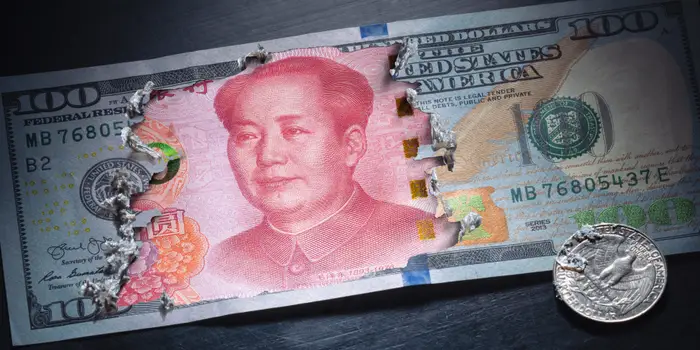Assesment Chinese Yuan Is The New Dollar
Chinese Yuan is the New Dollar
Rely
on your own resources
(Mao
ze Tung)
The United States Dollar is slowly being
replaced by the Chinese yuan. Financial and business academies have analyzed
that by the next ten (2030) years Chinese currency would likely to lead the
world’s fiscal records and will depose the American dollar.
With advent of Bretton
woods system, American Dollar has achieved highest peaks of both twentieth and
twenty-first century. This system
included an efficient foreign exchange system and all currencies were hold down
to U.S dollar. In addition, in the post Bretton wood years, dollar emerged as a
very dominant currency in the mid-20th century with its fixed values
by advancing the Nixon shock in 1970s and the Triffin’s dilemma in late 1980s.
These events dethroned all the regional currencies around and all the world’s
currencies got a peripheral position to U.S dollar which resulted in the centralization
of it and America became the largest partner in the global trade.
With the introduction of
significant economic reforms by Deng Xiaoping in 1978, China started to
transform into a superpower. China's GDP increased by 10% on average over the
three decades between 1980 and 2010, helping to bring half of its 1.3 billion
people out of poverty. Between 2003 and 2013, the Chinese economy expanded five
times in dollar terms, and at $9.2 trillion, it was clearly the second-largest
economy in the world.[1]
Therefore, having advancements in the economically globalized world by the end
of 20th century, China started to enlarge and expand its trade ties
initially with neighbors and latterly with the major continent of the world.
Especially with birth of Belt and Road Initiative (BRI), the regional
connectivity among countries enhanced and with this China started influencing
its economic ties with the neighbor and other countries of the world.
In the recent era, China
has become world’s largest trade companion: The Belt and Road Initiative
initially through Shanghai Corporation Organization (SCO) connected China with
60 countries. SCO aimed to bulk up the foreign exchange in local currencies to
put down the Western sanctions and both the major co-founders of the
organization agreed on a road map to bulk up local exchanges gradually and
reduce their dependence on U.S dollar[2]. Whereas
the China Pakistan Economic Corridor (CPEC) became a bridge for China to
enhance its economic power through interacting financially with Europe, Africa
and Asia. CPEC has now aggravated the economic cooperation among states with
its hundreds of projects specifically energy projects with Pakistan, Middle
Eastern Countries and Russia. CPEC advanced in a very exceeding manner that it
appeared as a great challenge for America and its soft power.
Once David Ricardo said;
“The Farmer and the Manufacturer can
no more live without profit and the labors with wages”
Correspondingly, In
the beginning, every country invested in CPEC but the exchange rates were in
the dollars because of dollar being a major foreign exchange currency. Dollar
being the centered trade exchange even does not make more than 2 percent of the
global reserved currencies, which was quite a heavy milestone for other countries
to reach the level of the USD in Foreign exchange (FOREX) markets. Same as
today China’s share in global trade is larger than United States and being the
major shareholder of the global trade, its currency was undermined because of
the exposed value of dollar that is why the dollar could not make a better hold
for china in world’s trade relations.[3] Anyhow
in 2018 China asked countries to start exchange in Chinese currency and every
country warmly welcomed the new deal. Pakistan appreciated the agreement and
allowed yuan-based bilateral trade with China which aggrandize the economic and
fiscal partnership between both countries.[4]
This was the first step China took to manage its currency level. Reports
suggest that China’s economic policy is apparently trying to enhance its export
values and for this it has acute the trade and investments in Chinese yuan.[5]
Now-a-days, in the
economically globalized world, the international system is entirely equipped
with the economic politics that every state is concentrating and paying heed to
their economic strategies to upheld their nation from economically down trodden
world and to make their country regionally strong. Belt and Road Initiative
through SCO and CPEC connecting the Asian, African, European and Middle-Eastern
Countries to enhance their regional connectivity through variety of projects:
at the core of this China has increased and intensified its forging alliances
with specifically the European and African states which are major partners of
the United States which will assist Beijing to revalue the Chinese yuan not
only to make it regionally strengthen currency but also to internationalize it
in the international system which will help out China and its allies to work
independently without having economic and financial sanction onto themselves.
As mentioned earlier,
there is a single exchange forum in international market which consider the
whole world as a unitary body which troublesome the underdeveloped and
developing world to strong their coins, countries like Iran which has huge
economic sanctions, Russia which is detreating economically after
Russia-Ukraine war, Pakistan which is equipped with huge debts and Eastern
African states which are in dark depths of poverty have entirely collapsed
financially after America’s emerged Capitalist system and liberal order in the
aftermath of Cold War, CPEC in the amid of these critical situations came up
with highly appreciating deals to assist the countries with under-develop
fiscal systems to uplift their country from still dark economic ages. Therefore,
in current years these countries have deep rooted their ties on Chinese
economic investments to boost their economies and to vanish out this single
market exchange system which is treating the whole deprived world as an
economic slave.
Since the last decade Chinese yuan has had a
dominant effect on U.S dollar. Even in 2015, the international monetary System
Approved the fiscal exchanges in Chinese yuan which labeled it as one of the
major strong currencies of the world as the current exchange rates of Yuan with
regard to Dollars are 1 yuan equals to 0.14$. this shows how swiftly the
Chinese currency has arisen to higher values in international fiscal systems.[6] Moreover,
the blatant steps and precautionay measure taken by China is its Cross-Border
Interbank Payments System (CIPS) which is built in countries including France, United Kingdom,
South Korea, North Korea, America, Japan and Russia. China has further
established the digital yuan projects which will result in a heavy cost for
united states dollar and it will prove to be a great hurt to American economic
hegemony in the world.[7]
Hence Chinese Currency (Yuan) is cautiously emerging as a threat for United States Dollar and for the international financial system quietly based on USDs. Over the last decade Beijing has vividly managed to expand its financial relationships and has become the world’s largest trade partner and facilitator. Well today Beijing has cautiously and carefully invested disorganizing the U.S oriented economic system in technologies, infrastructures, foreign aids Because Beijing is not only a single state which wants to detour the united states dollar but the major part of the world wants the same. Furthermore, the United States Sanction authority on economic developments through Society for Worldwide Interbank Financial Telecommunication would like to be drawn out by the rapid advancement of Chinese currency based fiscal system in the global exchange markets which will likely make the Chinese Yuan a new Dollar globally.
References
Bansal Rajesh and Singh Somya, (2021): China’s
Digital Yuan: an alternative to the Dollar-dominated Financial System: Carnegie
Endowment for international peace.
Pakistan’s
state bank Allow yuan-based trade
why
China’s Currency tangos with USD: Investopedia, accessed on 12/1/2022
https://www.investopedia.com/articles/forex/09/chinas-peg-to-the-dollar.asp
Picardo Elvis, (05/08/2019),: why China’s
currency Tangos with the USD: Investopedia.com, accessed on, 01/12/2022.
https://www.investopedia.com/articles/forex/09/chinas-peg-to-the-dollar.asp
Zoe
liu Zongyuan, (21/09/2022): china is quietly trying to
dethrone the Dollar: The financial Times.
https://foreignpolicy.com/2022/09/21/china-yuan-us-dollar-sco-currency/
Meng Xianming, etl, : the Impact of an Appreciation of
The Chinese Yuan on the Global trade.
Weiss Colin,
(10/2022),: Geopolitics and the U.S. Dollar’s future as a reserve Currency:
International Financial Discussion paper: Board of Governance of Federal
Reserve System.
Is the Chinese Currency the renminbi, dangerously
undervalued and a threst to the global economy: A symposium of views.
[1] Elvis Picardo, (05/08/2019),: why
China’s currency Tangos with the USD: Investopedia.com, accessed on,
01/12/2022.
https://www.investopedia.com/articles/forex/09/chinas-peg-to-the-dollar.asp
[2] Zoe liu Zongyuan, (21/09/2022): china is quietly trying to
dethrone the Dollar: The financial Times.
https://foreignpolicy.com/2022/09/21/china-yuan-us-dollar-sco-currency/
[3] Rajesh bansal and Somya Singh, (2021): China’s Digital Yuan: an alternative to the Dollar-dominated Financial System: Carnegie Endowment for international peace.
[4] Pakistan’s state bank Allow
yuan-based trade
[5] why China’s Currency tangos with
USD: Investopedia, accessed on 12/1/2022
https://www.investopedia.com/articles/forex/09/chinas-peg-to-the-dollar.asp
[6] exchange rates 1 November 2022
[7] Rajesh bansal and Somya Singh, (2021): China’s Digital Yuan: an alternative to the Dollar-dominated Financial System: Carnegie Endowment for international peace.










.jpeg)
.png)


